Euphorbia multiflorous - description, rules of care and reproduction
Ornamental shrub - multiflorous euphorbia - one of the most beautiful perennials, often found in household plots. The plant of the Euphorbiaceae family is widespread in Europe, Russia, Asia, Africa and Ukraine. Consider what it looks like and how to properly care for it.
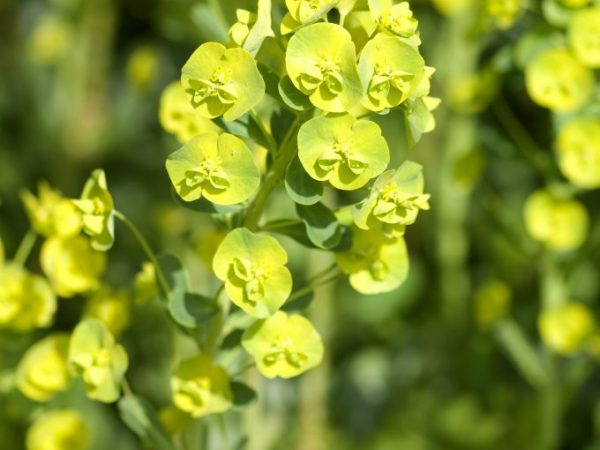
Euphorbia multicolor photo
general characteristics
The botanical name is euphorbia polychroma. A shrub plant no more than 70 cm in height is considered not only highly decorative, but also frost-resistant.
This herbaceous perennial is used in various garden compositions to give them brightness and originality.
The hardy shrub is able to thrive on rocky ground, mountain slopes and calcareous soil.
Stipules, which are the basis of inflorescences, are considered the main decorativeness. In the flowering phase from May to July, they acquire a rich color, which gives the plant brightness and saturation. The color can be different - from bright lemon to emerald tone. Shoots are green, erect, covered with golden leaves along the entire length.
All parts of the multicolored milkweed, except for the inflorescences, contain milky juice - an intercellular fluid that is poisonous. Therefore, when caring for it, you must wear rubber gloves.
It is important that the milk does not get on the mucous membranes of the eyes and into the oral cavity, as it can provoke poisoning and allergic manifestations.
Hybrid form
This plant has one decorative variety, which differ in size and color - Frostad flame.
The description includes several distinctive qualities:
- chartreuse flowers with yellowish bracts;
- blooms in May and finishes blooming in June;
- depending on the season, the leaves have a different color - in spring and summer they are green with a grayish tint and cream edging, in autumn they turn red;
- miniature bush - height 35-40 cm;
- grows well in a sunny or slightly shaded place.
Application in landscape
The shrub plant is readily used in garden landscape design:
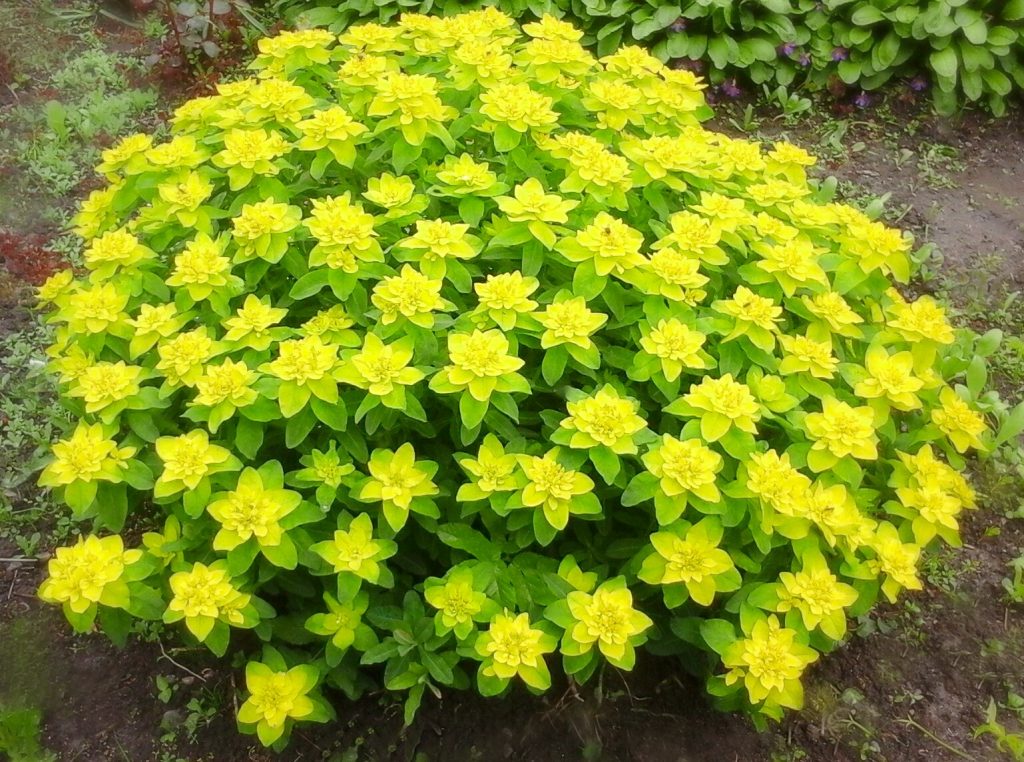
Euphorbia multiflorous in landscape design
- in mixborders;
- a good combination is obtained with undersized spruce, fir and juniper;
- perfectly tolerates the neighborhood of ground cover plants - sedum, zelenchuk, tenacious and antennae;
- in large flower beds, it is planted in groups, creating a lush and bright flower bed;
- also used in the creation of large rock gardens;
- many are grown for cutting - twigs with bright inflorescences stand for a long time in water, without losing their decorative effect for 10-12 days.
Purchase and adaptation
You can buy such a flower at any flower shop.
When choosing plants in pots or containers, pay attention to their condition. In healthy specimens:
- the aboveground part is fresh and juicy;
- stems, buds and leaves of a uniform green color, do not contain black and yellow spots, reddish growths;
- the surface of an earthen lump without acidification and mold.
Choose grown flowers that have already formed 2-3 stems with leaves. Such seedlings take root well after planting in the garden, since they have a developed root system.
For adaptation, give 2-3 weeks, then transplanted into open ground. During this period of time, you will be able to determine their condition - whether there are any parasites and infections.
If the plant begins to turn yellow or wither, it should be treated with chemicals. Give another 7 days for recovery, and only after that you can start the transplant.
Landing
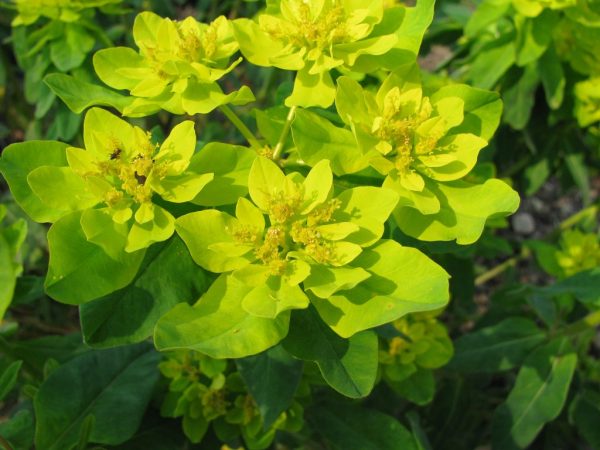
Euphorbia multiflorous cultivation and care
Planting is carried out in the spring before the beginning of the growing season - it is important to have time so that the plants do not begin to release leaves. So they will take root faster.
Purchased flowers are first watered, then removed from a container or pot, together with an earthen clod, they are transferred into the planting holes.
The size of the holes must correspond to the dimensions of the root system. One handful of pebbles or expanded clay are laid at the bottom to ensure the outflow of excess liquid. After that, sprinkle with a layer of fertile soil - a mixture of dug earth and compost (last year's manure). Mix in equal parts.
The roots are lowered, all the voids are filled up, tamped, watered. 3 liters of water is enough for one seedling. To prevent rapid evaporation of moisture, the bushes are sprinkled with garden soil.
When planting in groups, a certain distance is observed in order to avoid thickening of the plantings and the appearance of diseases and pests in the future. Planting scheme - between seedlings 50 cm, in a row 60 cm.
Transfer
Euphorbia polychroma can grow in one place for 3-4 years, after this period it is transplanted. Relocation is necessary, since the soil becomes poor over time and the plant loses its original decorative effect and grows slowly.
The bushes are watered abundantly, after an hour they are removed from the soil and, together with an earthen clod, are transplanted to a new place with fertile soil. The transplanting technique is the same as for planting.
A transplant of purchased copies is necessary after a three-week quarantine so that they have time to adapt.
When growing in a pot for transplanting, take a container 3-4 cm larger in diameter than the previous one. Use a ceramic or plastic pot with drainage holes in the bottom. A couple of handfuls of expanded clay are poured, then they are half filled with soil mixture from compost and garden soil, the roots are lowered, filled with the substrate to the top, the soil around the shoots is pressed, and watered.
An unscheduled transplant is required for diseased plants whose root system has rotted or damaged by harmful insects and infections. It is possible to determine the deterioration of the general condition of milkweed by the aerial part - the stems and leaves turn yellow, dry, wither.
Conditions of detention
All types of milkweed prefer to grow in a sunny area protected from the scorching sun at lunchtime.
It is planted among tall shrubs - roses, hydrangeas, keeping a certain distance. So there is no competition for space, moisture and nutrients.
When planting in the shade, it will not work to get a lush and bright flowering bush. He does not like waterlogging, so it should be planted on a flat area with well-drained land.
Prefers to grow on loamy or sandy loam soil with a high content of useful components. If the soil is knocked down, add a couple of 1 m² buckets of sand.
It develops poorly on acidified soil, the optimal level is 6 units. For deoxidation, calcite, dolomite flour, slaked lime or powdered chalk are used at the rate of 300 g per 1 m².
Humidity
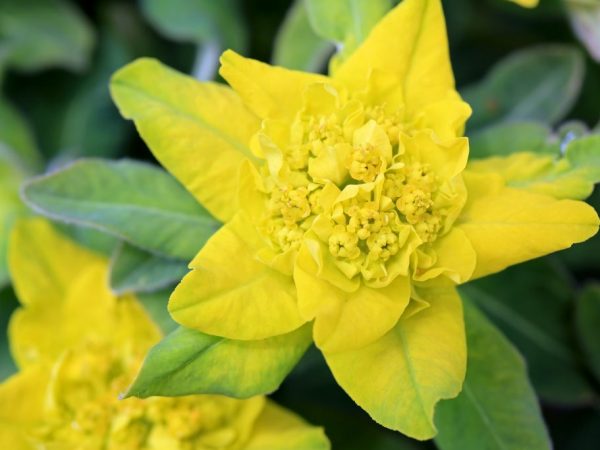
Euphorbia multiflorous seeds
Euphorbia multicolor reacts positively to frequent irrigation of the crown.Regular sprinkling with warm water in spring and summer promotes rapid growth of leaves and stems, washes away dirt and dust, and also protects against pests.
The frequency of spraying in the warm season is every 5 days. The procedure is carried out in the evening when the sun sets.
Temperature
Comfortable temperature in the warm season is 20-28 ° С.
The garden plant is grown everywhere, because it is adapted for outdoor use. In winter, it can safely endure even severe frosts, provided that the near-trunk zone is covered.
Lighting
The crop should be planted in a sunny place. During the growing season, it needs diffused daylight for 10 hours.
In autumn and winter, the flower does not need light, because it goes into a resting phase.
Care
It is not difficult to care for milkweed, so everyone, even a novice florist, can grow it. In the process of growth and development, it is necessary to provide several important conditions.
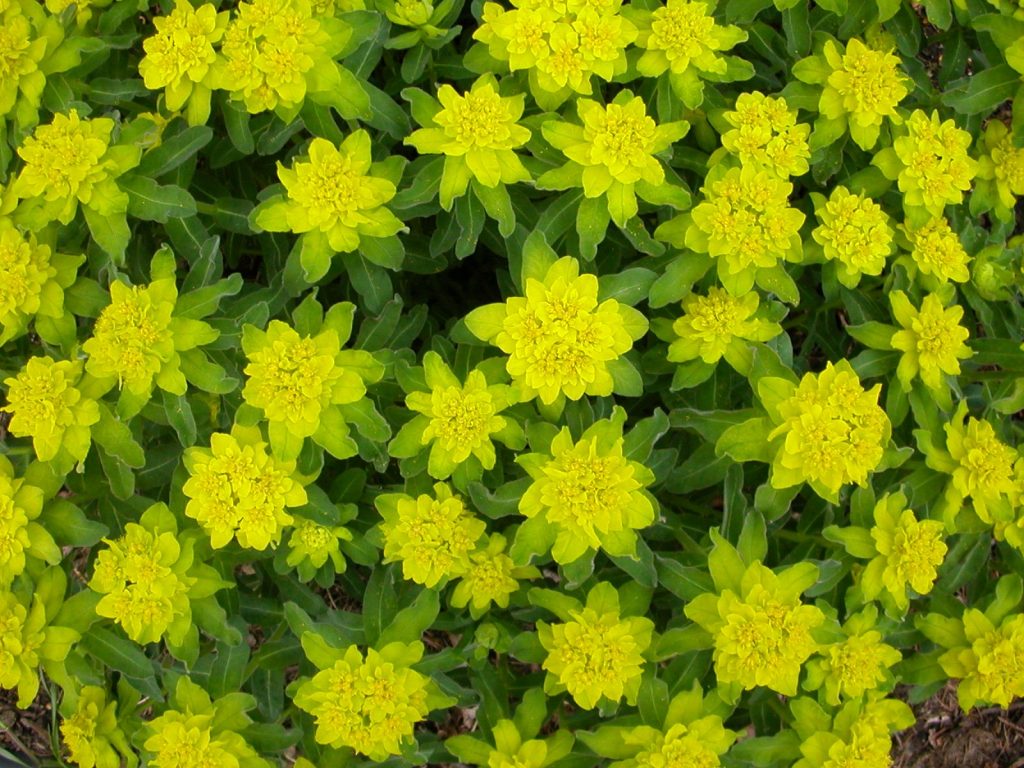
Euphorbia multicolor frosty flame
Watering
The plant is moisture-loving, but with frequent waterlogging, the root system rots. Watering should be regular but moderate. In the summer heat, the bush is moistened every two days.
In spring and autumn, the frequency is reduced - they are guided by the state of the soil. If it has dried out to a depth of 4-5 cm, it's time to water.
After wetting, loosening of the soil is required to maintain the moisture and air permeability of the soil. Loosens superficially and between rows to avoid injury to the root system.
Top dressing
Multiflorous euphorbia refers to the need for periodic feeding.
It is fertilized with special preparations for cacti throughout the growing season, twice a month.
For quick and high-quality assimilation of nutrients after feeding, the bushes are watered abundantly.
Pruning
Basic care for milkweed in this variety includes regular pruning. Forming for the bush is not needed - it initially forms a beautiful and lush crown, but you can trim the stems growing inward or in the wrong direction.
With the arrival of spring, it is necessary to carry out a sanitary haircut - cut out all dubious parts (yellowed, shrunken, broken off and frozen). So you can prevent the appearance of pests and diseases throughout the growing season.
A sterile and sharp instrument is used for trimming. After shearing, the shrub is irrigated with one of the restoring drugs - Epin or Heteroauxin.
Preparing for winter
This plant has increased frost resistance, therefore, it is suitable for growing in any climatic zone of our country, and does not need insulation.
Shelter is required for young plantings up to three years old. They begin to insulate in the fall a couple of weeks before the upcoming frost. First, they spud the near-trunk zone with last year's manure or sawdust, then cover the above-ground part with spruce branches.
The covering material is removed in the spring, when the snow thaws and the threat of recurrent frosts has passed.
Reproduction methods
Dividing the bush
This is one of the most effective methods that is often used during the rejuvenation of an adult milkweed - once every three years during the transplant process.

Euphorbia multicolor sun
The plant is watered abundantly, after an hour it is removed together with an earthen lump, dipped in a container of water to wash off the remains of the soil. The roots are dried, all non-viable fragments are removed, the bush is divided into several parts so that each of them has one stem with buds and 2-3 roots.
Places of cuts are powdered with charcoal, then planted according to the above-described planting scheme.
Seeds
This is a dioecious plant, so you can only distinguish male inflorescences from female ones during the flowering period. After collecting and drying the seeds.
Seeds are sown in the fall in open ground no later than the first half of September, so that they have time to build up the root system and green mass before the onset of cold weather.Dig holes 3-4 cm deep at a distance of 10-15 cm, lay the seed, sprinkle it with earth, water it.
You can sow seeds in the spring in a seedling box or plastic container with drainage holes in the bottom. Fill with a mixture of garden soil and compost (1: 1). They are planted at a distance of 5 cm, then covered with a thin layer of rotted manure, spilled with warm water, covered with foil.
They will sprout in two weeks. During this time, they need to be periodically sprayed, ventilated every day. As soon as two pairs of leaves appear on them, a pick is made in separate pots. The seedlings are removed together with a lump of earth and transferred to a nutrient substrate used for sowing. It is worth replanting in open ground in a month.
Cuttings
Cutting is one of the most popular breeding methods. Cuttings are cut in the spring. The apical shoots on the crown are chosen, which do not contain signs of disease. The optimal length of stems for planting is 10-15 cm. For quick and successful rooting, they can be placed in water for several hours with the addition of Epin's solution.

Euphorbia multiflorous euphorbia
They are planted in open ground in a sunny place. Holes are pulled out, a little expanded clay is laid on the bottom, then sprinkled on top with a mixture of last year's manure and garden soil. Shoots are installed at an angle to a depth of 3-4 cm, then covered with earth, compacted, watered.
In the first week, they need shading at lunchtime to prevent drying out and death. It is also necessary to water every other day, gently loosen the soil and mulch the near-stem zone.
Diseases and pests
In the process of growing, garden multiflorous euphorbia can damage various infections and parasites, if timely measures are not taken to eliminate them, the bush can quickly wither away.
| Diseases and pests | Signs | Treatment | Prophylaxis |
| Spider mite | Small cobweb on the underside of the leaves, yellowing in the affected area. The insect feeds on tissue juice and, at an advanced stage, can lead to the death of the bush. | Removal of damaged areas, treatment with acaricides - Aktellik or Aktara | Regular spraying, protection from the scorching sun in extreme heat |
| Whitefly | Small butterflies flying on the crown lay their eggs on the leaves in the axils. Caterpillars that were born gnaw through the leaves, leaving holes in them. | Treatment with one of the herbicides | Avoid thickening of plantings, regularly weed aisles and sprinkle with wood ash |
| Shield | Red plaques adhered to the surface of stems and leaves. They feed on the juice of all organs, the affected areas become yellowish, then brown, die off | Double treatment with Decis with an interval of 7 days | Regular inspection for damage, with minor damage to insects, they are harvested by hand, irrigated with a concentrated soap solution. You need to buy healthy plants, fertilize them regularly, water them, follow the planting scheme |
| Root rot | The main reason is the frequent waterlogging of the soil. The bush begins to rot in the lower part, later the crown turns yellow and withers. | Such a plant must be removed from the pot, washed off the remnants of the soil, remove all decayed fragments, treated with a fungicide, dried and transplanted to a new place. | Observe the watering regime |

